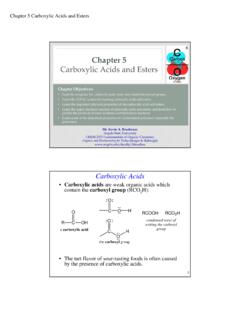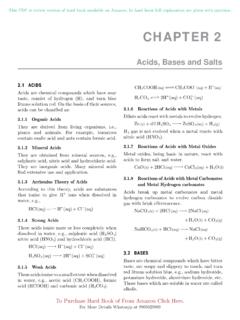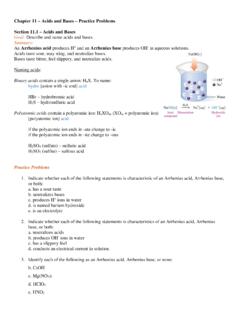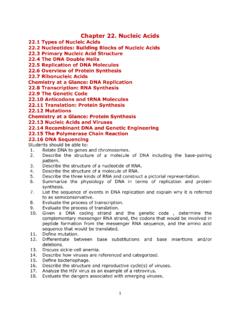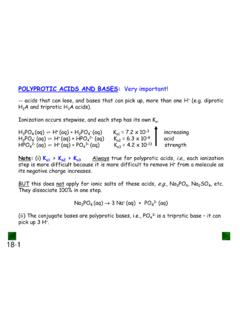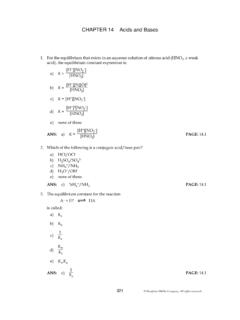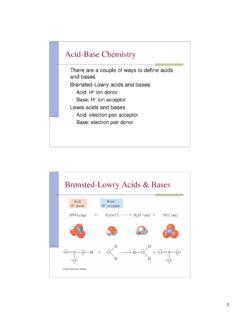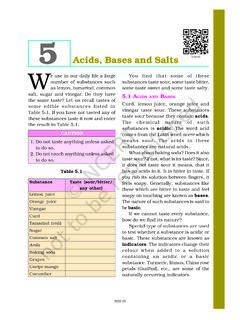Transcription of The Structure and Function of Nucleic Acids
1 The Structure and Functionof Nucleic AcidsRevised Bryce* and D. Pacini *Department of Biological Sciences, Napier University, Edinburgh, and Bolton School Boy s Division, BoltonThe Biochemistry Across the School Curriculum Group (BASC) was setup by the Biochemical Society in 1985. Its membership includes edu-cation professionals as well as Society members with an interest inschool science education. Its first task has been to produce this series ofbooklets, designed to help teachers of syllabuses which have a high bio-chemical topics covered by this series include: Essential Chemistry forBiochemistry; Enzymes and their Role in Biotechnology; Metabolism;Immunology; Photosynthesis;Recombinant DNA Technology; BiologicalMembranes; and The Biochemical Basis of information on the work of BASC and these booklets is availablefrom the Education Officer at the Biochemical Society, 59 PortlandPlace, London W1N on the content of this booklet will be welcomed by the SeriesEditor Mrs D.
2 Gull at the above 0 90449 834 4 The Biochemical Society 1998 First edition published 1991 All BASC material is copyright by the Biochemical Society. Extractsmay be photocopied for classroom work, but complete reproduction ofthe entire text or incorporation of any of the material with other doc-uments or coursework requires approval by the Biochemical by Holbrooks Printers Ltd, Portsmouth, Acids and genetic information transfer ..1 Learning and Structure of Nucleic Acids ..5 Learning ..7 Inorganic Nucleic Acids from their building di- and triphosphates ..9 Nucleic Acids ..10 DNA isolation, base composition and Structure ..12 RNA isolation, base composition and objectives ..21 Introduction ..21 The Meselson and Stahl experiment ..23 Mechanism of genetic objectives ..29 Introduction ..29 How many bases code for an amino acid ? ..31 Evidence for a triplet code ..32 Deciphering the codons ..34iv5 Transcription ..37 Learning objectives ..37 Introduction.
3 37 Mechanism of transcription .. objectives ..41 Introduction ..41 Activation of ..43 Elongation ..44 Termination ..45 Polysomes ..467 Assessment: past examination questions and ..47 Answers ..568 Laboratory practicals ..59 Extraction and characterization of DNA from of RNA ..61 Further practicals ..629 Source materials ..63 Textbooks ..63 Articles ..63 Teaching index ..65vForewordA study of the Structure and Function of Nucleic Acids is needed to beable to understand how information controlling the characteristics of anorganism is stored in the form of genes in a cell and how these genes aretransmitted to future generations of offspring. The rapid developmentsin the area of genetic engineering and recombinant DNA technology(which are covered in Booklet 7 of the BASC series) have only beenpossible as a result of detailed understanding of the Structure of DNAand RNA. It is therefore not surprising to see Nucleic Acids included inthe compulsory core subject matter of all of the linear and modular A-level Biology syllabuses.
4 The major purpose of these guidance notes is toprovide an account of the role of DNA and RNA in these processes in atleast sufficient detail for A-level study. Additional information moresuited for general interest, Oxbridge preparation or first-year under-graduate study is placed in shaded boxes of order to maximize the benefit of this booklet for A-level studentsand their teachers, a set of learning objectives have been included at thestart of chapters 1 6. These objectives are based upon the relevantknowledge and understanding statements of current A-level Biologysyllabuses. Chapter 7 consists of recent A-level examination questionsand answers and this should help students get a feel for the level of detailrequired. We are grateful to the various Examinations Boards, especiallythe Northern Examinations and Assessment Board (NEAB), for theirpermission to include this Acids and geneticinformation transferLearning objectivesEach student should, without reference to his or her notes, be able to: state that the genotype describes the genetic composition of an organism in terms of specific genes, alleles that it contains; state that the phenotype is the collection of visible characteristics which identify an individual organism; state that the phenotype of an individual depends not only on its genotype but also on the environment in which it lives.
5 And state that DNA, which is found in the nucleus of a cell, contains and is responsible for the transfer of genetic information, the , when we talk about genes and heredity we perhaps thinkimmediately of how children resemble their parents or, depending onour background knowledge, we may even think about Mendel and theheight and colour of his pea plants. This level of genetics is known asphenotypic expression, where the phenotypeof an individual is the col-lection of visible and recognizable characteristics by which that indi-vidual is phenotype is influenced by the environment as well as thegenotype; but this aspect is more appropriate to classical genetics and willnot concern us at the present time. In this section we are more concernedwith the collection of the inherited factors which determine these traits,1and this is a cell s genotypic expression. The genotypeis the genetic com-position of an organism in terms of the forms of specific genes, alleles,that it contains, and its study is referred to as molecular very fact that a child can resemble one or both parents meansthat there was some way in which the genetic information was passedfrom the parent to the child.
6 What then is the nature of the geneticmaterial? The answer to this question came from the experimentalobservations shown in Table to heredity than DNAIn similar types of nuclear transplantation experiments, scientists have recentlyrevealed that the environment of the nucleus ( the cytoplasm in which it findsitself) can alter the functioning of key genes, including those which determinebody have been referred to as epigeneticchanges, these beingchanges which affect the way DNA works rather than sequence could have implications for in vitrofertilization in Scientist(19 April 1997)Single-cell organisms take a siestaIn 1997 a short report appeared which indicated that a study on the patterns ofDNA synthesis in single-cell organisms revealed that cells synthesized DNA fromsunrise to about noon, then shut down synthesis for between three and sixhours, then restarted before explanation given for this phenomenon isthat this represents an evolutionary throwback to the Precambrian times whenthere was no ozone layer and hence the sun s ultraviolet light at its peak couldhave damaged the may have a future significance if the ozone layerdoes continue to Scientist(4 January 1997)Such studies represent the most conclusive evidence that DNA isresponsible for the transfer of genetic information, at least in micro-organisms and viruses.
7 The evidence that this is also true in higherorganisms (plants and animals), although somewhat less conclusive,leaves no doubt that this is the case. Since some virus particles have beenfound that have no DNA, but which have RNA instead, it is morecorrect to say that Nucleic Acids are the genetic information carriers .The exact roles of DNA and RNA in the complex process of thetransfer of genetic information are the subjects of subsequent sections ofthis Acids : Structure and functionNucleic Acids and genetic information transfer3 Table 1. Steps in the discovery of DNA as the genetic materialExperimenter(s) and datesDetails of procedureConclusionLate 19th century biologistsRemoval of the nucleus of the cell produced death, Something in the nucleus is responsible for a but removal of the same volume of cytoplasm did s 19th century biologistsRemoval of a cell nucleus followed by transplantation Something in the nucleus is responsible for of the nucleus from a different cell type changed the the phenotype of a and Function of the donor (1929)Dead, disease-producing, virulent strains of Pneumococcus Something had been transferred from the were able to transform harmless cells of non-virulentdead organisms that altered the phenotype of Pneumococcusinto lethal living and MacLeod (1944)These workers extracted the DNA from the virulentDNA is responsible for cell transformation Pneumococcusbacterium.
8 On adding it to a cell s these were transformed into disease-causing DNA contained no detectable protein and was unaffected by proteases, but the transformation was affected by use of and Chase (1953)These workers infected Escherichia colibacteria using aDNA is responsible for cell transformation radioactive strain of T2 bacteriophage virus in which a cell s atoms in the DNA and the sulphur atoms in the coat protein were revealed that only the DNA entered the bacteria, causing and Structure ofnucleic acidsLearning objectivesEach student should, without reference to his or her notes, be able to: state that DNA is composed of phosphate, deoxyribose and the four major bases: adenine, guanine, cytosine and thymine; state that RNA is composed of phosphate, ribose, adenine, guanine, cytosine and uracil; state that DNA and RNA are polymers of nucleotide subunits; state that a nucleotide is composed of a phosphate group, a pentose sugar and one of the four corresponding bases; state that the backbone of a DNA molecule is a chain of repeating deoxyribose phosphate units; state that the backbone of an RNA molecule is a chain of repeating ribose phosphate units; state that each molecule of DNA is usually composed of two chains; state that in DNA, adenine will only bind with thymine on opposite chains and guanine will only bind with cytosine on opposite chains; state that the two linked chains in DNA are arranged in a double helix; state that there are three principal types of RNA, these being messenger RNA (mRNA), transfer RNA (tRNA) and ribosomal RNA (rRNA), which are all single-stranded molecules; state the Function of the three principal types of RNA; draw a diagram of a simple ladder-like representation of a DNA molecule.
9 And state that DNA is a stable polynucleotide which contains coded genetic information for inherited the Nucleic Acids were first discovered in 1868, by FriedrichMiescher working with pus cells obtained from discarded surgicalbandages, it was not really until the early 1940s that the chemistry andbiology of the Nucleic Acids were set on firm , Nucleic Acids can be subdivided into two types: deoxy-ribonucleic acid (DNA)and ribonucleic acid (RNA). Both DNA andRNA have been shown to consist of three groups of molecules: pentose(5-carbon-atom) sugars; organic bases; and inorganic are only two types of sugar present in Nucleic Acids , ribosewhichis present solely in RNA (hence its name) and deoxyribosewhich ispresent solely in DNA (again, the sugar gives rise to the name deoxy-ribonucleic acid ). The chemical structures for these compounds areshown here:The prefix deoxy means without oxygen , and we can see fromthe structures that the only difference between them is the absence of anoxygen in the deoxyribose sugar (see shaded area).
10 Both sugars contain 5carbon atoms (pentose sugars) and for convenience we number these asshown in the next figure. The dash or prime ( ) on, for example, the 5indicates the carbon in the ribose ring. The purine or pyrimidine rings(see Bases, below) are numbered without primes in order to and Structure of Nucleic acidsRiboseDeoxyriboseOHOHOHOHOHNo OHgroupOHOHOCH2 HOCH2 BasesThe nucleotide bases found in Nucleic Acids are related either to thepurinering system or to the pyrimidinering DNA we find principally four different bases: adenine (A),guanine (G),cytosine (C) andthymine (T). The first two are derivedfrom purine whereas the remaining two are derived from pyrimidine. InRNA we find principally four different bases; adenine, guanine andcytosine as in DNA. The fourth base in RNA, however, is not thyminebut instead the pyrimidine-derived base , uracil(U). The chemical structures for each of the five bases are shown Acids : Structure and function7 OHOHOHCHCCHCOHHHOCH25 4 1 2 3 PurinePyrimidineNNNNHNNP urinesAdenineGuanineCytosineUracilThymin ePyrimidinesNHNHNH2 NHNCH3 NNH2NH2 HNNHNNNNHNHNHOOOOOCNCONote: A-level students are not expected to recognize these structuralformulae.


